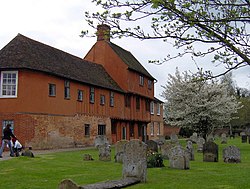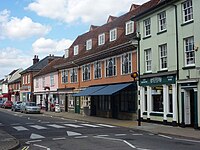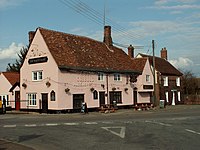Hadleigh, Suffolk
| Hadleigh | |
| Suffolk | |
|---|---|
 The Guildhall, Hadleigh | |
| Location | |
| Grid reference: | TM030425 |
| Location: | 52°2’38"N, 0°57’40"E |
| Data | |
| Population: | 7,239 (2001) |
| Post town: | Ipswich |
| Postcode: | IP7 |
| Dialling code: | 01473 |
| Local Government | |
| Council: | Babergh |
| Parliamentary constituency: |
South Suffolk |
Hadleigh is an ancient market town in Suffolk. It is to be found between the larger towns of Sudbury and Ipswich.
Hadleigh's ancient charm is renowned. It is a little place of brightly lime-washed old cottages unsullied by the worst demands of modernity, in a restful part of Suffolk.
History
Guthrum, King of the Danes, is said to be buried in the grounds of St. Mary Church in the town.[1] He was defeated by King Alfred in the 9th century, but was restored by Alfred as King of the East Anglia after baptism.
Hadleigh was one of the East Anglian towns that derived its prosperity from its wool and cloth industries. It has a 15th century timber-framed Guildhall and many fine examples of timber and brick listed buildings, some with highly detailed 17th century plasterwork or "pargeting". Most of these buildings can be found in the High Street, Benton Street, and the immediate area of these streets.
The deanery, which is next to the church, is a Grade I listed building.[2] It is a highly distinctive brick building.
Like its near-neighbour, East Bergholt, Hadleigh was also known during the 16th century for its Protestant radicalism, Rowland Taylor, a noted preacher from the town (and his curate, Richard Yeoman), was martyred during the reign of Queen Mary I. In a reversal of this tradition though, the Oxford Movement was said to have been founded here in 1833 following a meeting in the deanery.
The town to this day supports a United Reformed Church, a Baptist chapel and a Salvation Army congregation, as well as the Church of England church and a Roman Catholic church.
In April 2011 the historic clock bell at the parish church of St Mary The Virgin Church, was silenced by a pair of nesting jackdaws.[3]
Culture

The Hadleigh Show, first held in 1840 and also known as 'the May Show', is one of the oldest and most popular agricultural shows in East Anglia.[4]
The noted 20th century painter and plantsman Cedric Morris moved to Hadleigh in the 1930s, establishing the East Anglian School of Painting and Drawing at Benton End, a rambling farmhouse on the edge of the town.[5]
The BBC television series Lovejoy was partly filmed in Hadleigh for its first two series.
Sport & Leisure
Hadleigh has a Non-League football club Hadleigh United FC who play at Millfield.
The town's bowls and cricket clubs are among the oldest in Suffolk.
Economy

Hadleigh is home to the Hadleigh Maid chocolate company.[6]
The Brett Works site off Pound Lane used to be the home of Brett Valley joinery. It has now been allocated by Babergh District Council as a site for a foodstore. Tesco have proposed plans for the site;[7] however, Babergh District rejected Tesco's plans in July 2011.
Outside links
- Town website
- Hadleigh Businesses Chamber of Commerce
- Babergh District Council
- Hadleigh Tennis Club
- Hadleigh Cricket Club
References
- ↑ D. Dumville and M. Lapidge (eds) Annals of St. Neots Cambridge 1984
- ↑ http://www.britishlistedbuildings.co.uk/en-277634-deanery-tower-hadleigh
- ↑ "Hadleigh: Nesting jackdaws force church bell to be silenced", By Matt Bunn at eadt.co.uk
- ↑ Hadleigh Show
- ↑ Richard Morphet Cedric Morris The Tate Gallery 1984 ISBN 0-946590-06-0 pp59-60
- ↑ Hadleigh Maid http://www.hadleighmaid.com/
- ↑ Proposed Tesco store http://www.brett-works.co.uk/